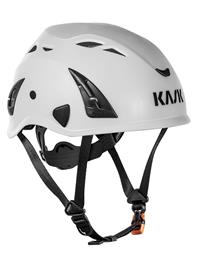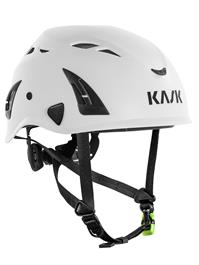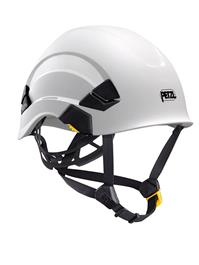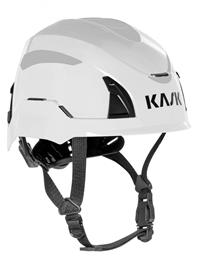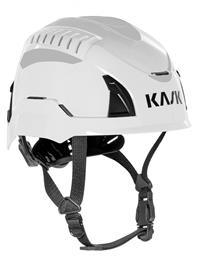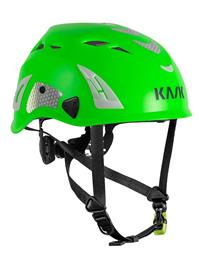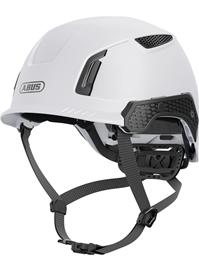Kask Superplasma AQ Helmet
The lightweight Kask Superplasma AQ is a vented safety helmet for industrial use conforming to EN397. The Superplasma AQ’s lightness is made possible by the high-density polystyrene insert, which absorbs impact forces. The ‘weaker’ chinstrap which releases between 150N and 250N (15kg-25kg), limits the risk of choking or strangulation, making this safety helmet particularly suitable for Ambulance Hazardous Area Response Teams (HART). It also meets the optional requirements of the mountaineering Standard for helmets EN12492:
- Side deformation (LD)
- Molten metal splash (MM)
- Very low temperatures (-30°C)
- Shock absorption
- Penetration
Although a safety helmet conforming to EN397 is particularly suitable as a groundwork helmet, some Health & Safety officers accept it as a work at height safety helmet. It’s fit for purpose for both uses.
Kask Superplasma PL Helmet
The lightweight Kask Superplasma PL is a vented climbing helmet designed for industrial use and conforming to EN12492. The Super Plasma PL’s lightness is made possible by the high-density polystyrene insert, which absorbs impact forces. The strong chinstrap, which releases above 500N (50kg), ensures that the helmet stays on your head in the event of an impact. This makes it an ideal work at height helmet and also a technical rope rescue helmet.
Although the Super Plasma helmet has not been through the tests for EN397 (Industrial safety helmets), it uses exactly the same shell as the Kask Plasma AQ which has. The Superplasma therefore meets or exceeds the following tests:
- Side deformation (LD)
- Molten metal splash (MM)
- Very low temperatures (-30°C)
- Shock absorption
- Penetration
Kask Superplasma PL Helmet
The lightweight Kask Superplasma PL is a vented climbing helmet designed for industrial use and conforming to EN12492. The Super Plasma PL’s lightness is made possible by the high-density polystyrene insert, which absorbs impact forces. The strong chinstrap, which releases above 500N (50kg), ensures that the helmet stays on your head in the event of an impact. This makes it an ideal work at height helmet and also a technical rope rescue helmet.
Although the Super Plasma helmet has not been through the tests for EN397 (Industrial safety helmets), it uses exactly the same shell as the Kask Plasma AQ which has. The Superplasma therefore meets or exceeds the following tests:
- Side deformation (LD)
- Molten metal splash (MM)
- Very low temperatures (-30°C)
- Shock absorption
- Penetration
The Petzl Vertex safety helmet has an adjustable dual strength chinstrap to cater for work at height, the Wind power generation sector, rope rescue and ground work. The 6-point suspended webbing cradle contours to your head and Petzl's Centrefit system keeps the shell centred. The Flip&Fit system helps to ensure the perfect secure fit and folds into the shell for easy storage. Shock absorption is achieved through deformation of the shell.
There is a complete line of entirely modular accessories and replacement parts.
This helmet was launched in 2019 and replaces the Vertex Best helmet.
Kask Quantum Helmet
The Kask Quantum helmet is designed for wildland fire fighting, technical rescue and mountaineering, conforming to EN12492, EN 16471, EN 16473.
Kask Quantum Cabrio Helmet
The Kask Quantum helmet is designed for wildland fire fighting, technical rescue and mountaineering, conforming to EN12492, EN 16471, EN 16473.
Kask Superplasma PL Hi Viz Helmet
The lightweight Kask Superplasma PL Hi Viz is a vented climbing helmet designed for industrial use and conforming to EN12492. It has fluorescent headlamp clips (not on the black version) and reflective stickers. The Super Plasma PL’s lightness is made possible by the high-density polystyrene insert, which absorbs impact forces. The strong chinstrap, which releases above 500N (50kg), ensures that the helmet stays on your head in the event of an impact. This makes it an ideal work at height helmet and also a technical rope rescue helmet.
Although the Super Plasma helmet has not been through the tests for EN397 (Industrial safety helmets), it uses exactly the same shell as the Kask Plasma AQ which has. The Superplasma therefore meets or exceeds the following tests:
- Side deformation (LD)
- Molten metal splash (MM)
- Very low temperatures (-30°C)
- Shock absorption
- Penetration
ABUS have a long heritage in making Professional Cycling helmets and they have now used this expertise to produce the SPECTOR helmet for the Working at Height Professionals. Innovative and design-optimised helmet geometry will give maximum protection and comfort.
The helmet comes in a range of colours - White, Black, Signal Orange, High-viz Yellow, Blue and Red.
Helmets
The choice of helmet will depend on the type of work being undertaken and the environment in which it will be used. An EN397 weaker chinstrap may be more appropriate in places where there is a risk of snagging and thus a chocking hazard (such as in a confined space). Similarly, where it is important to ensure the helmet does not come off during a fall, such as, when there may be multiple impacts in a fall, the stronger EN12492 may be deemed most appropriate. For rope access, as noted in the IRATA ICOP 2.7.12, 'Users should check carefully the performance of industrial helmets conforming to European Standard EN397 as they might not have the all the performance requirements for the safety of rope access technicians, e.g. front, side and rear energy absorption capacity (not specified in EN397); appropriate chinstrap and fastening arrangement; low temperature use and ventilation (optional in EN397). Helmets utilizing expanded polystyrene shells (common in helmets conforming to European Standard EN12492) are unlikely to withstand the rigours of industrial use and, therefore, are generally not recommended'.
A guide to the Conformity Standards:
| EN397 | Industrial safety helmets |
| EN12492 | Mountaineering equipment. Helmets for mountaineers. Safety requirements and test methods |
| EN50365 | Electrically insulating helmets for use on low voltage installations |
| ANSI Z87.1 | American National Standards Institute - Occupational and Educational Personal Eye and Face Protection Devices |
| ANSI Z89.1 (class C) | American National Standards Institute - Industrial Head Protection - Class C (Conductive) provide no electrical protection |
| ANSI Z89.1 (class E) | American National Standards Institute - Industrial Head Protection - Class E (Electrical) are tested to withstand 20,000 volts |
| UIAA 106 | International Climbing and Mountaineering Federation - Helmets |
*Please note some helmets conform only in part to certain standards. Certifications for each helmet are indicated in the Manufacturer's Instructions / Instructions for Use. There is currently no specific European helmet standard for work at height.
